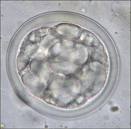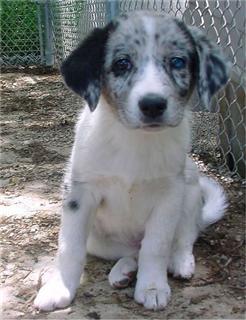Giardia (Giardia canis)
Your dog has diarrhea, is listless, and has lost weight...
The symptoms are typical of several diseases, but if your pup has had contact with dirty (or potentially contaminated) water or with dogs showing similar signs, Giardiasis should at least be suspected.
Giardia are protozoans, tiny, one-celled parasitic life forms with the potential to cause serious illness. Some dogs are carriers who show no symptoms, but others get sick and need treatment. |
 |
Like many disease organisms, Giardia mature in stages. Unlike many others, no time elapses between infestation with the dormant phase and activation of the disease. The cysts (the inactive form) are found in contaminated water and feces.
Once ingested by the dog, the cysts open and discharge the mobile form known as the trophozoite, a pear-shaped critter with whip-like flagella that propel it through the intestine. If the dog is healthy, the trophozoites may live in the lower digestive tract for years. If the dog has an immature or overburdened immune system, the trophozoites continue to multiply by dividing and can cause the debilitating disease.
<< Back to Top >>
The life cycle of Giardia is still somewhat of a mystery. Scientists do know that the trophozoites encyst at some point, and that the cysts are passed into the environment when the dog defecates, but the exact timing and mechanism are not yet known. It is also unclear whether the protozoans are a single species or several species, each with a specific host. Suffice to say, however, that Giardia is an equal opportunity disease that infects several species of animals, including humans.
Thus the presence of cysts in the environment can trigger an outbreak in people as well as pets. Cysts can remain viable for several weeks or months in cold, wet environments, so areas littered with feces should be avoided and piles should be removed from backyards.
<< Back to Top >>
Diagnosis and Treatment:
Symptoms
Large populations of Giardia can interfere with the absorption of food and produce feces that are soft, light-colored, and greasy. Mucus from the large intestine may also indicate that the large intestine is irritated even though the colony of active protozoa remains in the small intestine. Blood tests appear normal with the possible exception of an increase in a type of white blood cells and mild anemia.
Diagnosis
Since diarrhea is a common symptom of intestinal infection, causes such as Salmonella and Campylobacter are generally ruled out before testing for Giardia is done. Direct microscopic inspection of feces is necessary to determine the presence of the protozoan. Examination of soft feces may reveal the active trophozoites, and cysts may be found in firm excrement. The number of cysts can vary from day to day, so best chances of detecting this form of Giardia lies in collecting samples over three days for a fecal flotation test or conducting individual tests every two or three days until at least three tests have been done. A quicker test does exist, but it is more expensive and requires an experienced technician to run.
<< Back to Top >>
Treatment
There are several options of treatment , some with two- or three-day protocols and others needing seven-to-10 days to complete the job. Flagyl (Metronidazole) is an old stand-by treatment for bacterial infestations that cause diarrhea and is about 60-70 percent effective in curing giardiasis. However, Flagyl has potentially serious side-effects in some animals, including vomiting, anorexia, liver toxicity, and some neurological signs, and it cannot be used in pregnant dogs. In a recent study, Panacur (Fenbendazole), which is approved for use in treating dogs with roundworm, hookworm, and whipworm, has been shown to be effective in treating canine giardiasis. Panacur is safe to use in puppies at least six weeks of age.
In large kennels, mass treatment of all dogs is preferable, and the kennel and exercise areas should be thoroughly disinfected. Kennel runs should be steam-cleaned and left to dry for several days before dogs are reintroduced. Lysol, ammonia, and bleach are effective decontamination agents.
Because Giardia crosses species and can infect people, sanitation is important when caring for dogs. Kennel workers and pet owners alike should be sure to wash hands after cleaning dog runs or removing feces from yards, and babies and toddlers should be kept away from dogs that have diarrhea. When traveling with Fido, owners should prevent him from drinking potentially infected water in streams, ponds, or swamps and, if possible, avoid public areas polluted with feces.
<< Back to Top >>
References
1. Giardia in Dogs by Maggie Fisher, BVetMed, MRCVS; at Vet On-Line, (http://www.priory.com/vet.htm) a service of Priory Lodge Education Limited.
2. Treatment information is a blend of information from Dr. Fisher and from “Giardia,” an article by Dr. Holly Frisby, Drs. Foster and Smith Veterinary Services Department,(http://www.drsfostersmith.com).
<< Back to Top >>
Coccidia (Coccidiosis)
A Cause of Diarrhea
Coccidia are small protozoans (one-celled organisms) that multiply in the intestinal tracts of dogs and cats, most commonly in puppies and kittens less than six months of age, in adult animals whose immune system is suppressed, or in animals who are stressed in other ways (e.g.; change in ownership, other disease present). |
 |
In dogs and cats, most coccidia are of the genus called Isospora. Isospora canis and I. ohioensis are the species most often encountered in dogs. Regardless of which species is present, we generally refer to the disease as coccidiosis. As a puppy ages, he tends to develop a natural immunity to the effects of coccidia. As an adult, he may carry coccidia in his intestines, and shed the cyst in the feces, but experience no ill effects.
<< Back to Top >>
How are coccidia transmitted?
A puppy is not born with the coccidia organisms in his intestine. However, once born, the puppy is frequently exposed to his mother's feces, and if the mother is shedding the infective cysts in her feces, then the young animals will likely ingest them and coccidia will develop within their intestines. Since young puppies, usually those less than six months of age, have no immunity to coccidia, the organisms reproduce in great numbers and parasitize the young animal's intestines. Oftentimes, this has severe effects.
From exposure to the coccidia in feces to the onset of the illness is about 13 days. Most puppies who are ill from coccidia are, therefore, two weeks of age and older. Although most infections are the result of spread from the mother, this is not always the case. Any infected puppy or kitten is contagious to other puppies or kittens. In breeding facilities, shelters, animal hospitals, etc., it is wise to isolate those infected from those that are not.
<< Back to Top >>
What are the symptoms of coccidiosis?
The primary sign of an animal suffering with coccidiosis is diarrhea. The diarrhea may be mild to severe depending on the level of infection. Blood and mucous may be present, especially in advanced cases. Severely affected animals may also vomit, lose their appetite, become dehydrated, and in some instances, die from the disease.
Most infected puppies encountered by the authors are in the four to twelve week age group. The possibility of coccidiosis should always be considered when a loose stool or diarrhea is encountered in this age group. A microscopic fecal exam by a veterinarian will detect the cysts confirming a diagnosis.
<< Back to Top >>
What are the risks?
Although many cases are mild, it is not uncommon to see severe, bloody diarrhea result in dehydration and even death. This is most common in animals who are ill or infected with other parasites, bacteria, or viruses. Coccidiosis is very contagious, especially among young puppies. Entire kennels may become contaminated, with puppies of many age groups simultaneously affected.
What is the treatment of coccidiosis?
It should be mentioned that stress plays a role in the development of coccidiosis. It is not uncommon for a seemingly healthy puppy to arrive at his new home and develop diarrhea several days later leading to a diagnosis of coccidia. If the puppy has been at the new home for less than thirteen days, then he had coccidia before he arrived. Remember, the incubation period (from exposure to illness) is about thirteen days. If the puppy has been with his new owner several weeks, then the exposure to coccidia most likely occurred after the animal arrived at the new home.
Fortunately, coccidiosis is treatable. Drugs such as sulfadimethoxine (Albon®) and trimethoprim-sulfadiazine (Tribrissen®) have been effective in the treatment and prevention of coccidia. Because these drugs do not kill the organisms, but rather inhibit their reproduction capabilities, elimination of coccidia from the intestine is not rapid. By stopping the ability of the protozoa to reproduce, time is allowed for the puppy's own immunity to develop and remove the organisms.
<< Back to Top >>
How is coccidiosis prevented or controlled?
Because coccidia is spread by the feces of carrier animals, it is very important to practice strict sanitation. All fecal material should be removed. Housing needs to be such that food and water cannot become contaminated with feces. Clean water should be provided at all times. Most disinfectants do not work well against coccidia; incineration of the feces, and steam cleaning, immersion in boiling water, or a 10% ammonia solution are the best methods to kill coccidia. Coccidia can withstand freezing.
Cockroaches and flies can mechanically carry coccidia from one place to another. Mice and other animals can ingest the coccidia and when killed and eaten by a dog, for instance, can infect the dog. Therefore, insect and rodent control is very important in preventing coccidiosis.
The coccidia species of dogs and cats do not infect humans.
References:
Race Foster, DVM
Marty Smith, DVM
Drs. Foster & Smith, Inc.
Peteducation.com
<< Back to Top >>
|



